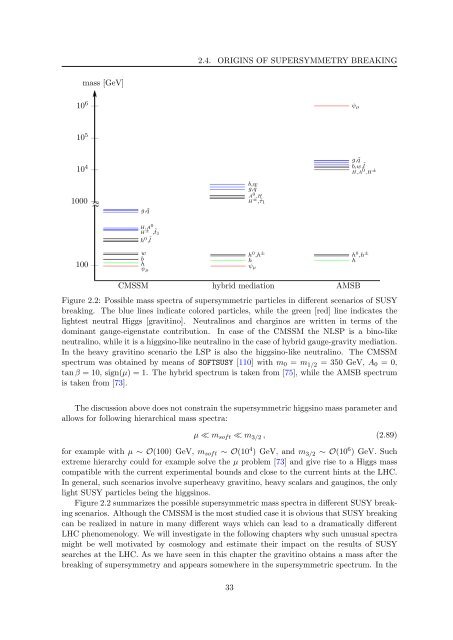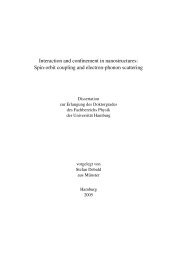Gravitinos and hidden Supersymmetry at the LHC - Universität ...
Gravitinos and hidden Supersymmetry at the LHC - Universität ...
Gravitinos and hidden Supersymmetry at the LHC - Universität ...
Create successful ePaper yourself
Turn your PDF publications into a flip-book with our unique Google optimized e-Paper software.
2.4. ORIGINS OF SUPERSYMMETRY BREAKING<br />
10 6 mass [GeV]<br />
ψ µ<br />
10 5<br />
10 4<br />
g,˜q<br />
b,w,˜l<br />
H,A 0 ,H ±<br />
1000<br />
g,˜q<br />
b,w g,˜q<br />
A 0 ,H<br />
H ± ,˜τ 1<br />
100<br />
H,A 0<br />
H ± ,˜t 1<br />
h 0 ,˜l<br />
b w h ψµ<br />
h 0 ,h ±<br />
h<br />
ψ µ<br />
h 0 ,h ±<br />
h<br />
CMSSM<br />
hybrid medi<strong>at</strong>ion<br />
AMSB<br />
Figure 2.2: Possible mass spectra of supersymmetric particles in different scenarios of SUSY<br />
breaking. The blue lines indic<strong>at</strong>e colored particles, while <strong>the</strong> green [red] line indic<strong>at</strong>es <strong>the</strong><br />
lightest neutral Higgs [gravitino]. Neutralinos <strong>and</strong> charginos are written in terms of <strong>the</strong><br />
dominant gauge-eigenst<strong>at</strong>e contribution. In case of <strong>the</strong> CMSSM <strong>the</strong> NLSP is a bino-like<br />
neutralino, while it is a higgsino-like neutralino in <strong>the</strong> case of hybrid gauge-gravity medi<strong>at</strong>ion.<br />
In <strong>the</strong> heavy gravitino scenario <strong>the</strong> LSP is also <strong>the</strong> higgsino-like neutralino. The CMSSM<br />
spectrum was obtained by means of SOFTSUSY [110] with m 0 = m 1/2 = 350 GeV, A 0 = 0,<br />
tan β = 10, sign(µ) = 1. The hybrid spectrum is taken from [75], while <strong>the</strong> AMSB spectrum<br />
is taken from [73].<br />
The discussion above does not constrain <strong>the</strong> supersymmetric higgsino mass parameter <strong>and</strong><br />
allows for following hierarchical mass spectra:<br />
µ ≪ m soft ≪ m 3/2 , (2.89)<br />
for example with µ ∼ O(100) GeV, m soft ∼ O(10 4 ) GeV, <strong>and</strong> m 3/2 ∼ O(10 6 ) GeV. Such<br />
extreme hierarchy could for example solve <strong>the</strong> µ problem [73] <strong>and</strong> give rise to a Higgs mass<br />
comp<strong>at</strong>ible with <strong>the</strong> current experimental bounds <strong>and</strong> close to <strong>the</strong> current hints <strong>at</strong> <strong>the</strong> <strong>LHC</strong>.<br />
In general, such scenarios involve superheavy gravitino, heavy scalars <strong>and</strong> gauginos, <strong>the</strong> only<br />
light SUSY particles being <strong>the</strong> higgsinos.<br />
Figure 2.2 summarizes <strong>the</strong> possible supersymmetric mass spectra in different SUSY breaking<br />
scenarios. Although <strong>the</strong> CMSSM is <strong>the</strong> most studied case it is obvious th<strong>at</strong> SUSY breaking<br />
can be realized in n<strong>at</strong>ure in many different ways which can lead to a dram<strong>at</strong>ically different<br />
<strong>LHC</strong> phenomenology. We will investig<strong>at</strong>e in <strong>the</strong> following chapters why such unusual spectra<br />
might be well motiv<strong>at</strong>ed by cosmology <strong>and</strong> estim<strong>at</strong>e <strong>the</strong>ir impact on <strong>the</strong> results of SUSY<br />
searches <strong>at</strong> <strong>the</strong> <strong>LHC</strong>. As we have seen in this chapter <strong>the</strong> gravitino obtains a mass after <strong>the</strong><br />
breaking of supersymmetry <strong>and</strong> appears somewhere in <strong>the</strong> supersymmetric spectrum. In <strong>the</strong><br />
33

















